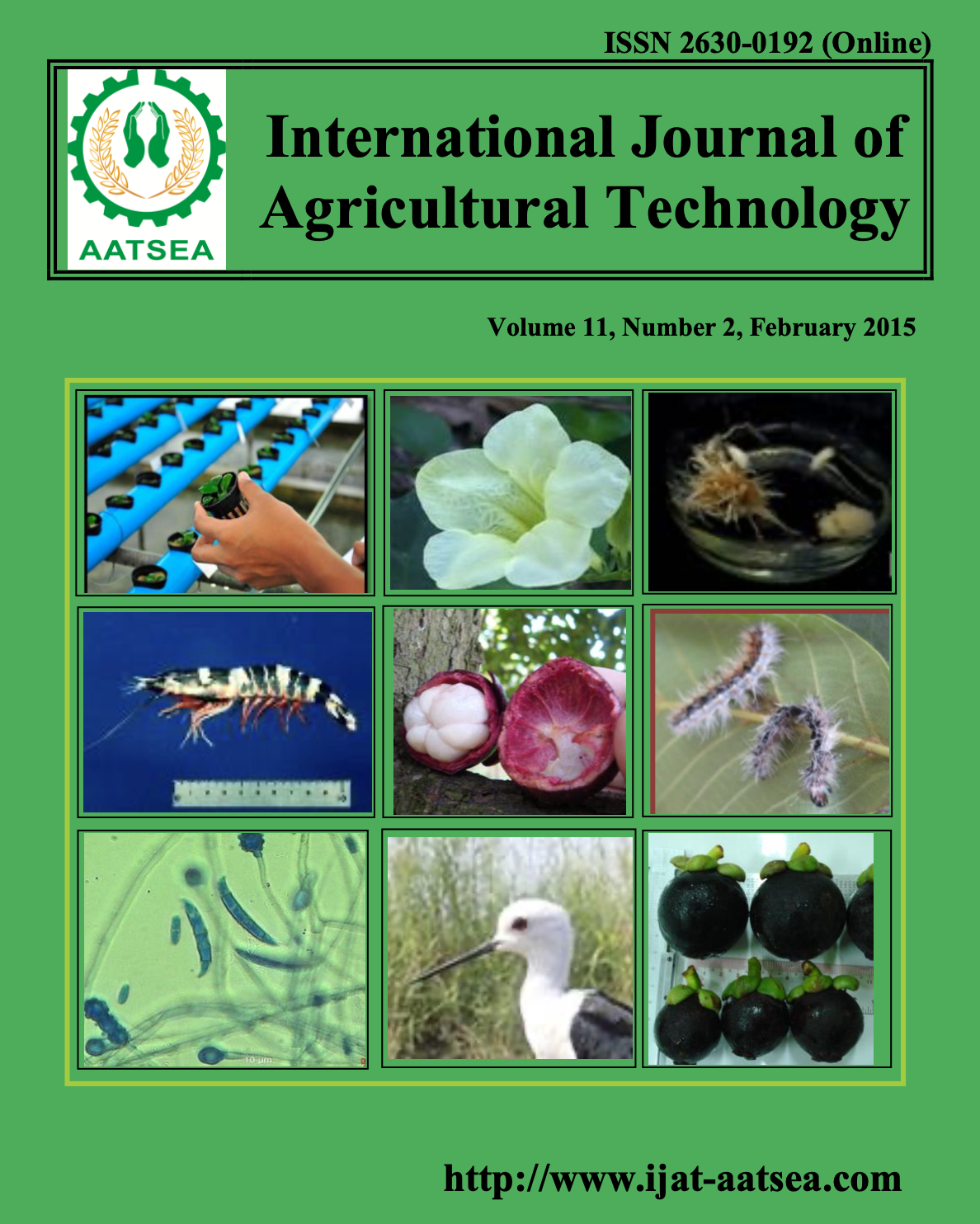Efficacy of insecticidal control in pomelo fruit fly IPM program in Nakhon Si Thammarat province, Thailand
Main Article Content
Abstract
The major problem of pomelo production is fruit fly (Tephritidae; Diptera), that damaging causes fruits to fall from the trees so that it is necessary for farmers to use chemicals for controlling continuously. The IPM program for controlling fruit flies were used in Taptim Siam pomelo orchards in Pakpanang district, Nakhon Si Thammarat province, Thailand, from May 2012 to August 2013, with 4-time spraying, 10 days apart during the period of 3-month-old pomelo fruits. The experimental design using RCBD with 3 replications and 6 methods (M) was: 1.(M1)imidacloprid10%SL+imidacloprid 10%SL+fipronil 5%SC+ imidacloprid 10%SL, 2.(M2) abamectin 1.8% EC+ imidacloprid 10%SL+ fipronil 5%SC+ abamectin 1.8% EC, 3. (M3) petroleum oil 83.9% EC + imidacloprid 10%SL+ fipronil 5%SC+ petroleum oil 83.9% EC, 4.(M4) Thai neem extract (aza. 0.05%)+ imidacloprid 10%SL+ fipronil 5%SC+ Thai neem extract (aza. 0.05%), 5.(M5: farmer method) abamectin 1.8% EC+ abamectin 1.8% EC + abamectin 1.8% EC +abamectin 1.8% EC and 6.(M6) control (non treated). The results revealed that, the average numbers of fruit damage (sting mark per fruit) before sprayed were 0.49-0.72 sting mark per fruit, not significantly different (p>0.05) from the control. The average numbers of fruit damage after application IPM program at the time of 3,4,5 and 6 month-old pomelo fruits, found that all methods were significantly difference (p<0.01) from control (non treated), were 0.50-1.05, 0.60-1.39, 0.65-1.39 and 0.75-1.39 sting mark per fruit, respectively. The highest effectiveness method at harvesting stage(6-month-old pomelo fruits) was M5 (81.35%), followed by M1, M2 and M3 at81.29 81.29 and 78.22 %, respectively. The lowest effectiveness method was M4 (76.98%) compared with control (non treated).
Article Details

This work is licensed under a Creative Commons Attribution-NonCommercial-NoDerivatives 4.0 International License.
References
DOA (2010). Good agricultural Practice (GAP) for pomelo. Retrieved from http://www. doa.go.th.
DOA (2014). Plant extracts: insecticidal control. Retrieved from http://www. it.doa.go.th/ pibai/ pibai/n11/v_11- jan/kayaipon.html
DOAE (2013). Taptim Siam pomelo. Retrieved from http://www. production.doae.go.th/ webboard/ webboard_board_list.php?wb_id.
Drew, R. A. I. and Hancock, D. L. (1994). The Bactrocera dorsalis complex of the fruit flies (Diptera:). Bulletin of Entomological Research Supplement Series 2:1-68.
FAO (2014). Integrated Pest Management (IPM). Retrieved from http://www.fao.org/ agriculture/crops/thematic-sitemap/ theme/ pests/ipm/en.
Jirasurat, M. (1987). The use poison bait fruit flies protection. Paper the training insect course – Animal pests and protection 9 time From 24 March to April 1987. Insect pest of fruit Entomology place. Department of Agriculture. Bangkok.
Metcalf, R. L. (1990). Chemical ecology of decline fruit flies (Diptera: Tephritidae). Annals of the Entomological Society of America 83:1017-1030.
Sukkaard, N. (2010). Taptim Siam pomelo in Pakpanang district, Nakhon Si Thammarat Province. Retrieved from http://www. nakhonsri@doae.go.th.
US. EPA. (2014). Integrated Pest Management (IPM) Principles. Retrieved from http://www.epa.gov/opp00001 /factsheets/ipm.htm.


